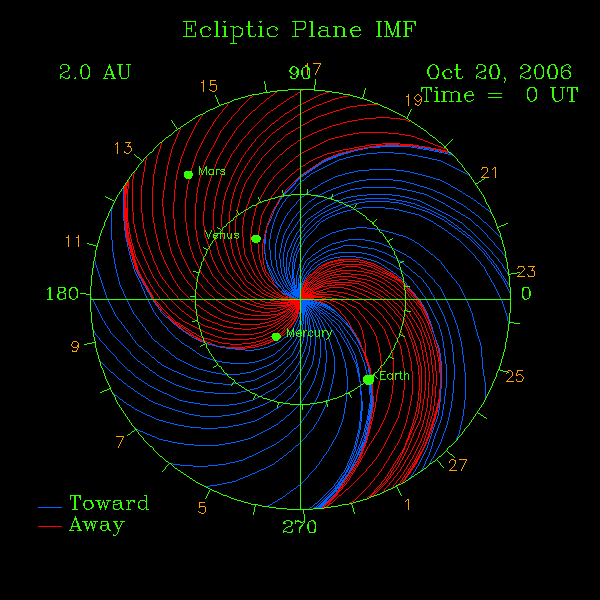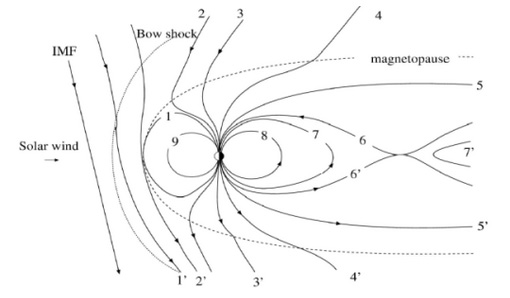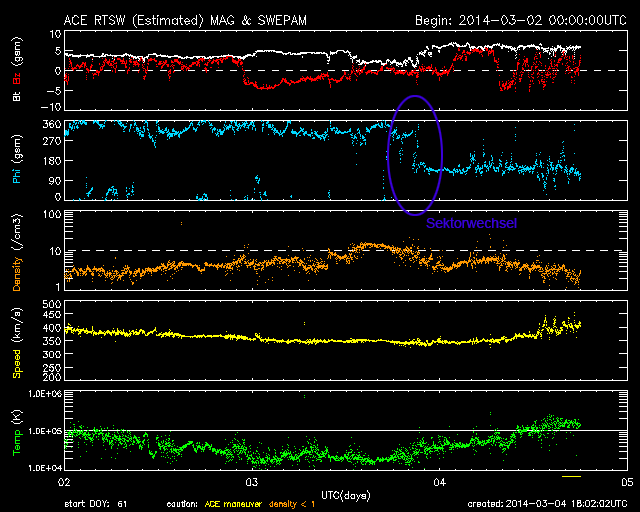Interplanetary Magnetic Field
Like the Earth, the Sun also has a magnetic field. However, this solar magnetic field does not end at the solar surface but extends into the realm of the planets. It is carried into this interplanetary space with the solar particles of the solar wind, which is why it is also referred to as the interplanetary magnetic field (IMF). At the edge of the solar system, the solar wind encounters the interstellar medium with its own, the interstellar, magnetic field. Here at the heliopause, the non-gravitational influence of the Sun ends.
A particular periodicity of the interplanetary magnetic field arises due to the solar rotation. This draws the footpoints of the magnetic field lines with it during its rotation, while the actual field lines run radially into the outer solar system with the solar wind. This ultimately results in a spiral image of the IMF, known as the Parker spiral, often compared to a lawn sprinkler.
The solar magnetic field is a "normal" dipole field. However, this is somewhat chaotically altered by sunspots, each bringing their own magnetic structure. In a projection of the IMF into the plane of the planets (ecliptic), field lines with north or south polarity are not represented; instead, the magnetic flux direction at the footpoints of the field lines is considered. If the flux exits the solar surface, it is referred to as "away" field lines, marked red in the following diagrams. Analogously, incoming field lines are labeled "toward" and marked in blue. In this diagram, only the field lines that can interact with the Earth's magnetic field are considered, resulting in a sectorization of the Parker spiral into corresponding red and blue areas due to local structures like sunspots and coronal holes. This can vary from just one blue and one red area to several blue and red areas, depending on how active the Sun is and how chaotic the structures near the solar equator are.
Strength and Orientation of the IMF
Current Orientation of the IMF
Live Plot
Current Orientation of the Interplanetary Magnetic Field (Source: iSWA)
Current orientation of the interplanetary magnetic field (Source: iSWA)
Heliospheric Current Sheet (HCS)
As seen above, the IMF is divided into sectors. At the points where two different sectors meet, there is a special layer called the Heliospheric Current Sheet (HCS for short).
When the Earth moves from one sector into another, that is, crosses the HCS, it is referred to as a sector change or an HCS-Crossing. The sector change lasts about 5-10 hours and can be observed through the "Phi Curve" on the ACE satellite. During a sector change, the angle depicted by the light blue graph changes by ~180°. The curve can fluctuate quite strongly back and forth during the change (see the 1st figure below).
If the HCS is within the plasma cloud of a coronal mass ejection, the geomagnetic effects of this CME are often stronger than with simple CMEs without the involvement of the HCS. Even weak CMEs can cause bright auroras. An example of such an aurora event was the bright aurora of February 27/28, 2014.






